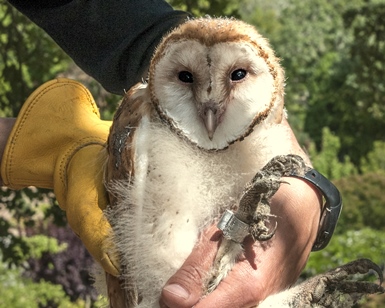San Rafael, CA – Marin County Parks plans to continue its downward trend on herbicide use and ramp up non-chemical treatments of invasive plants, according to a 2015 Integrated Pest Management (IPM) Annual Report that will be circulated at the March 1 meeting of the Marin County Board of Supervisors.
 Owls are an important and award-winning part of the County's biological control methods for pest management (Sue Bryer photo).
Owls are an important and award-winning part of the County's biological control methods for pest management (Sue Bryer photo).
A concerted effort to reduce chemical use was a top priority of the 2015 IPM Program, and it resulted in a variety of partnerships, experiments, and good old-fashioned elbow grease. Volunteers provided nearly 8,000 hours out of 37,000 total hours of labor to physically eradicate invasive vegetation such as french broom, scotch broom, thistles, fennel and non-native grasses.
“The County’s award-winning IPM Program continues to lead the way regionally as well as nationally by aggressively focusing on non-chemical IPM alternatives and staying abreast of current trends and technology,” said Chris Chamberlain, a Marin County Parks Superintendent and the County’s IPM Coordinator.
Of the 147 parks and County facilities maintained by Marin County Parks (ranging from traffic medians to roads to the Marin County Civic Center), 126 were managed without the use of pesticides. Some pesticide-free sites included popular destinations such as McNears Beach Park near San Rafael, Stafford Lake Park near Novato, Paradise Beach Park near Tiburon, and the Mill Valley/Sausalito Multiuse Path.
With support from the Board of Supervisors, Parks implemented more restrictions of glyphosate weed control products in 2015 in response to widespread safety concerns. Staff will limit glyphosate use to “critical use” sites that pose a significant risk to agriculture, protected plant and wildlife habitats, and public safety (such as wildfire threat, pedestrian and traffic issues, and worker safety).
”We heard the concerns of our residents and responded,” said Interim Parks Director Pat O’Brien. “Once again, it’s a demonstration that constructive public feedback can lead to policy change. It’s a success story. We value the relationships we’ve built out in the community and want to continue building on them.”
Alternative pest control methods will be emphasized in the coming years, including biological control with owls and insects, cultural control with changed work practices, and mechanical and physical control with mulches, screen barriers, and steam sterilization.
For more information on vegetation management in the Marin County Open Space District (MCOSD), which does not fall under the County’s IPM ordinance, visit the webpage. Vegetation management in open space is guided by the Vegetation and Biodiversity Management Plan, both because the MCOSD is a special district and because the goals for vegetation management in wildlands – where fire safety and the protection of rare species and biodiversity are the priority – are vastly different than the largely aesthetic goals for County's buildings, medians, parks, and landscaped areas.
Partnerships with community groups are a key component of non-chemical methods and listed in the annual report as one of the most important achievements of 2015. For instance, Parks has worked with the Invasive Spartina Project and Save the Bay at Hal Brown Park in Kentfield, utilizing the efforts of a dozen high school students via a One Tam initiative called the Linking Individuals to their Natural Community (LINC).
Since 1983, the County has been committed to reducing herbicide use. Its first IPM ordinance was adopted in 1998, and its implementation has led to significant reductions in chemical uses over the past 18 years, as detailed in the report. In 2012, the California Department of Pesticide Regulation included the County of Marin in its annual IPM Innovator Awards for its successes. The Berkeley-based group Raptors Are the Solution awarded Marin County its Owl Wise Leader award in 2015 for its groundbreaking integrated pest management program that minimizes use of herbicides and pesticides.
All county pesticide and herbicide use, along with previous IPM Commission annual reports and meeting archives, are available at marincountyparks.org.